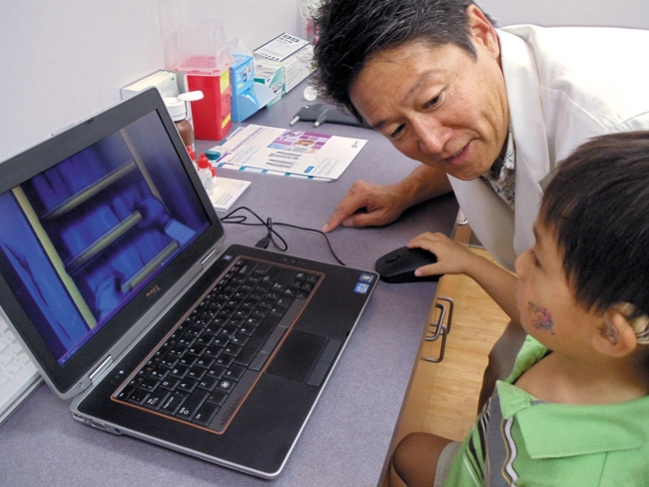A Focus On Keiki Eye Health
Dr. Khan Lau
Optometrist and founding partner at “blink”
Where did you receive your schooling/training?
I did my undergraduate work at Cal State-Fullerton and my doctorate at the University of Missouri-St. Louis. I recently completed my MBA at the University of California-Irvine.
mw-dih-091113-drkhanlau-2
I have worked as an optometrist for about 20 years. After working with a commercial organization, I decided to branch out with some friends, Dr. Linda Wong and Dr. Kyle Oroku, to create something trendy and more patient-centric. We have an office in the Pan Am Building near Ala Moana Center and will be opening in Waimalu by the end of September. We hope to have a downtown location before the end of the year. We’ve put a lot into our marketing, letting potential patients know that we will be open for business soon. It’s amazing to think how challenging but rewarding it can be when you’re marketing your optometry practice while welcoming new patients.
Being that this is Children’s Eye Health and Safety Month, can you talk about the latest in keiki eye care?
Children’s Eye Health and Safety Month ties in well with going back to school. It’s a good time to address vision awareness as it relates to our keiki. Many people don’t know that one out of four children have an unrecognized vision deficiency. There are many bright kids who go through school and do poorly because they can’t see the board, or they get headaches and eye strain when they’re doing their bookwork or reading.
We have technology called EyeSpy 20/20, which is like a video game but it tests children’s vision. The program detects unrecognized vision problems in our keiki in an innocuous way so they don’t feel like they’re being tested.
Our practice focuses on emerging technologies, and we integrate those technologies into traditional care. This differentiates us. It’s not that we practice any differently, but we have procedures to do things that other practitioners might either miss or discount.
What other latest technology do you use?
The second-biggest piece of technology that we use is a panoramic retinal camera, Optomap, that allows us to see and photograph the retina without dilating your eyes. In a traditional eye exam, a patient’s eyes need to be dilated in order for us to see the back of the eye to verify that it’s healthy. The effects of dilation usually last from four to six hours, so a patient can’t see properly to drive or work until it wears off. With opto-mapping, which only takes a few minutes, there is no need for dilation, which saves our patients time and inconvenience. What that means is that, at the end of the exam, you don’t have to wear those funky sunglasses and you don’t have to have somebody else drive you home. You also can select your eyewear immediately, because your eyes are still able to see normally. Of course, there are times when your eyes have to be dilated.
Can you say something about your mobile practice?
I provide eye care to seniors in several independent living centers who don’t want to or cannot easily leave the center to get their eyes checked. We bring the office to them. We check for glaucoma because we have a large Asian population and Asians have a disproportionately higher incidence of glaucoma. We also look for diabetes. The population of diabetics is rising locally and nationally. One of the first places diabetes manifests is in the back of the eye. I have provided services at mobile clinics in Third World countries and learned to compact whatever it is that we need into the trunk of a car, drop it on the site and set it up.
Any memorable experiences with eye exams in other countries?
The first mission I went on was to Albania which, at the time, was pretty lawless. We had to cut the clinic short because there were a lot of paramilitary people coming through. Soon after the closure, a war started in neighboring Yugoslavia. Unfortunately, we didn’t get to see as many patients as we usually do on that mission.
On average, we go in with a team of 20 to 30 people, including six to eight doctors. In a 10-day period, we see 16,000 to 25,000 patients and dispense free eyewear to them. Many of these patients not only have unrecognized visual needs, but they don’t have the resources to purchase eyewear. We offered recycled, donated eyewear that is matched to the patient’s prescription.
I’ve also had the opportunity to serve people in China, Thailand, Mexico and Peru. The last place I went was Benin, in East Africa. One funny story is that we dispensed Cartier-framed prescription glasses to an elderly man. The frame alone was probably worth $5,000 or $6,000. But this gentleman had never seen so clearly or felt so “rich.” On these missions, you realize the importance of vision. When people in Third World countries can’t see to do their trade, they can’t work, and that means they can’t feed their families. When we provide sight to them again, we are not just helping the one person but, many times, the whole family.
Anything you’d like to add?
Most eye care offices close by 5 p.m. but we’re open until 7 p.m. for the convenience to our patients. We plan to go to a seven-day-a-week schedule as soon as we can.
We have partnered with Dr. Hugo Higa, on the ground floor of the Pan Am Building. We provide vision care and he provides surgical eye care. As soon as we see a surgical problem, we can refer to him and it can be fixed immediately. Patients don’t have to go anywhere else.






